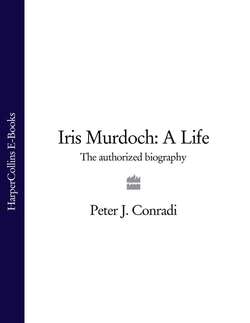Читать книгу Iris Murdoch: A Life: The Authorized Biography - Peter Conradi J. - Страница 28
3 The Clean-Cut Rational World 1932—1938
ОглавлениеEarly in 1932 Hughes and Iris travelled down to Badminton School1 (motto: ‘Pro omnibus quisque, pro Deo omnes’*) in a suburb of Bristol to meet the head, the redoubtable Miss Beatrice May Baker, known as ‘BMB’. In an article in Queen magazine in 1931, Miss Baker had emphasised the school’s ideal of service, the duties of simplicity in dress and living, and the proper use of money. Above all, and admirably, ‘a school can no longer be a self-contained little community … it should be related to the world outside’.
Badminton was not then necessarily the West Country school with the greatest social cachet, but it was likely to appeal to liberal and free-thinking parents such as Rene and Hughes, who did not object to religion in others, but happened not to go in for it much themselves, even at Christmas or Easter. The school was small – 163 girls, of whom ninety-six were boarders – internationally-minded, ‘forward-looking’, tolerant and liberal.2 Though sporty, it was not inhospitable to the arts. The distinguished painter Mary Fedden (Trevelyan) was there, as were the daughters of the sculptor Bernard Leach, painter Stanley Spencer, publisher Victor Gollancz and writer Naomi Mitchison. Indira Gandhi (née Nehru) was briefly there in Iris’s time,3 complaining to her father, imprisoned by the British for many years, about ‘all the stupid rules and regulations’,*and mourning her mother’s recent death. Iris would recall her as ‘very unhappy, very lonely, intensely worried about her father and her country and thoroughly uncertain about the future’.4
On this first visit Iris, only twelve, entered the Northcote drawing-room with Hughes and felt tongue-tied. She looked about and thought how beautiful and calm the room was. Pale sunshine was coming in through the tall windows. She was always to recall Miss Baker in that ‘cool light’.5 BMB was five foot six and lithe, dressed typically in pastel green with a white blouse, had an oval, very sunburnt, leathery and somehow ageless face with flat, centrally-parted silver hair over which she wore a black velvet band. Many a girl feared that BMB could read her innermost thoughts. She had the brightest of blue eyes, a sudden and quick-fading smile, a springy step in flat-heeled and polished shoes. She loved her dogs, probably at this time ‘Major’, a lean, short-haired, leggy Belgian hound, recalled neither as beautiful nor especially affectionate.
Happily, Hughes ‘got on jolly well’ with BMB, said Iris. ‘They respected each other,’ said John Bayley.6 As for Iris, at first she feared BMB. Respect came later, followed by a strong and loyal affection. BMB was eventually to be the first of a long series of authoritative and influential surrogate parent-figures, giving thrust to each of Iris’s tendencies towards other-centredness, puritanism, stoicism and idealism.
Iris was exactly the serious-minded, academic type of girl BMB most loved to bring on, with enough strength of character to resist her desire to dominate, yet enough malleability to undergo some moulding, and she would become BMB’s favourite. BMB lived to be ninety-seven, and Iris stayed in touch.7 When she fell in love with John, Iris sought her old headmistress’s approval before marrying him. And Iris was to be, after Dame Sybil Thorndike and Lord Caradon, Badminton’s official School Visitor from 1992, when she wrote an oratorio for the school choir. She had dreams of BMB in later life, and of her bee garden.8 In 1981, following a formal dinner after she was awarded an honorary doctorate from Bristol University, she alarmed her companion by taking him on an unheralded and uncanny midnight walk inside the school, in term-time, to revisit old haunts.9 It might have been of BMB that Iris was thinking when she wrote of brisk and bleakly sensible Norah Shaddox-Brown, tireless 1930s Fabian warhorse in The Time of the Angels: ‘The clean-cut rational world for which she had campaigned had not materialized, and she had never come to terms with the more bewildering world that really existed.’ Clean-cut rationalism and the League of Nations could not cope with Hitler: ‘Nazism was incredible – that was a part of its strength.’10
It was later to be said of Iris that she was a ‘poor girl who only just made it into a rich girls’ school’.11 She did indeed, with great brio and sparkle,12 win one of the first two available open scholarships to Badminton – the other went to her friend Ann Leech, a doctor’s daughter. It was happily one strength of the school that girls from prosperous homes never dared mention their ponies or foreign holidays – ‘bad form … absolutely out’.13The school secretary Miss Colebrook wrote to Hughes on 29 June 1932 that the announcement of Iris’s scholarship was in The Times, the Manchester Guardian and the local press: ‘It looks very well.’14
